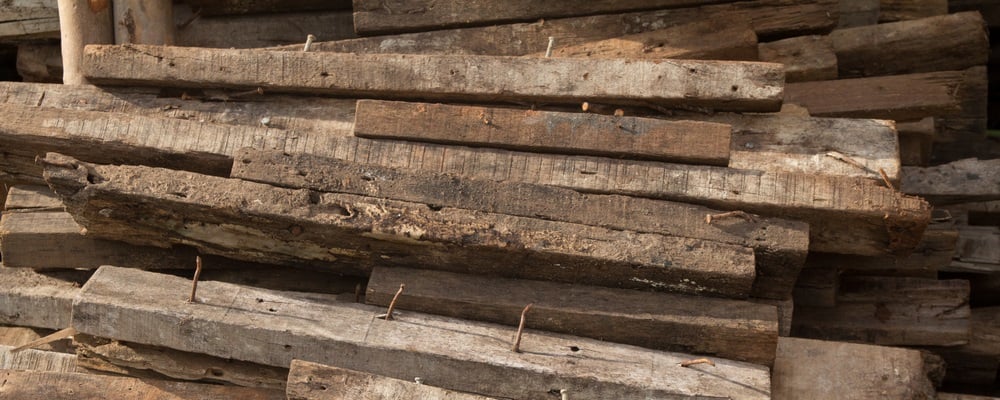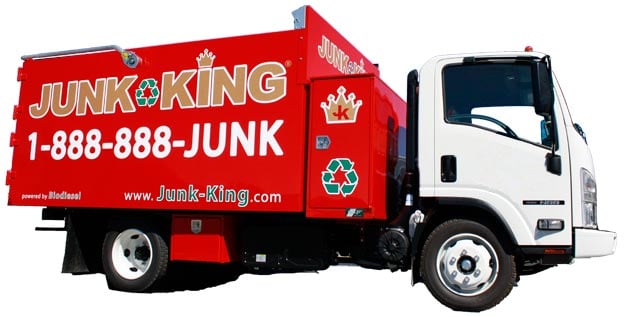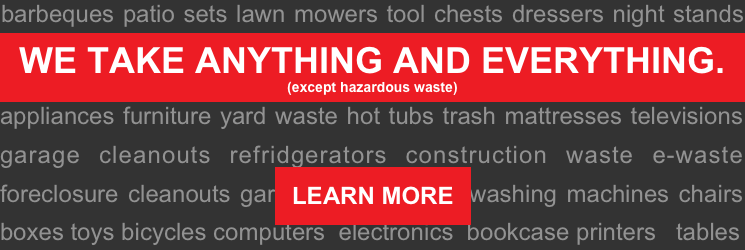
If you’re going to replace your fence, deck, or wooden railing this spring, odds are you’ll need to get rid of the old materials. But how do you dispose of old wood debris properly?
Not all wood products are the same and knowing what you’re working with and how it can - or cannot - be disposed of is critical, especially if you’re planning to use a landfill.
Home, Sweet, Home - Except for the Upkeep and Repairs and...
The sad reality of home ownership is that nothing lasts forever.
While that may not see true for a mortgage payment, that aside, the structures on or around your home need to be replaced from time to time.
Take a typical residential roof, for example. These can vary in regards to their lifespan.
As an article from money.usnews.com reported,
“Slate, copper and tile roofs can last more than 50 years. Homeowners with wood shake roofs should expect them to last about 30 years, while fiber cement shingles last about 25 years and asphalt shingle/composition roofs last about 20 years, the NAHB found.”
And a typical concrete driveway has a lifespan of about 30 years.
Typically, vinyl siding lasts between 20 and 40 years and the amount of sun a home receives, the weather and other forces can affect how long it lasts.
Most homes with traditional siding that's not vinyl need to be repainted.
According to one source,
"Exteriors should be painted every 5 to 10 years, depending on the quality of paint and craftsmanship it was painted with last time. Here are some guidelines based on exterior surface: Wood surfaces need to be painted every 3 to 7 years. Aluminum siding needs to be painted about every 5 years."
Inside a home, the carpet should be replaced every 6 to 7 years. If maintained properly, however, it can last in excess of 10 years. Other types of flooring such as tile, wood and laminate can last as long as 25-30 years, on the other hand.
But these are mostly hard and impervious surfaces and materials that are designed to withstand weather, moisture and heat.
That’s usually not the case with outdoor structures built with wood.
The Trouble With Lumber
Wood is a durable, versatile and beautiful building material that has been used in home construction probably from the beginning of, well, constructing homes!
It is used extensively today in its most natural, basic form as well as in composite and various laminate products.
For many homeowners, nothing beats the beauty and feel of a natural wood deck or gazebo. And, for the most part, wood can’t be beat for it’s combination of strength, workability and product variety.
However, no wood is as durable as stone, concrete or steel. And structures built primarily with wood have limited lifespans even in the best of conditions.
For most homes this would be structures such as fences, decks, gazebos, and tool or storage sheds. In addition, there may be some smaller storage structures, wooden playsets for the kids, and even the skirting around hot tubs or above-ground swimming pools.
The problem is that all of this outdoor wood construction has a limited lifespan.
For example, most experts agree that exposed wood decks that have had a sealing agent or a wood preservative routinely applied only have an average life expectancy of 10 to 15 years. In the best conditions, a wood deck can last 20 years, according to a National Association of Home Builders study.
A deck can last 20 to 25 years in dry areas, but is likely to last only 10 to 15 years in the South, where there is more rain and humidity.
And what about that old wood fence in your backyard? It depends on a few things, actually.
Each type of typical wood fence material has a different lifespan. The longest is cedar, with anywhere from 15 to 30 years, and pine boards can last from about five years to as many as 12. If your wood fence has been treated properly, its lifespan can be far greater. You can expect a pine fence to last up to 20 years, on average, while treated cedar can last up to 40 years!
But that brings up another yard junk removal issue: treated wood, which differs from untreated wood when it comes time to dispose of it.

Not All Wood Waste Is “Green”
When we speak of household, or residential, junk removal and wood waste, it’s best to think of wood in terms of categories. In fact, there are four generally accepted categories of household wood waste:
- Yard waste
- Untreated wood
- Treated/painted wood
- Home goods
Yard Waste
Your yard can be a source of wood that can be put to good use in your own garden or landscaping. Composting makes use of carbon-rich “brown” material - limbs and branches - to aerate compost piles and provide food for the bacteria which breaks down organic matter. Many communities have regulations for wood waste that differ from place to place.
Untreated Wood
Untreated scrap lumber from backyard fences, decks and home improvement projects has a number of uses when recycled. For example, depending on the type of can be chipped and used in compost or mulch. It can also be turned into particle board or chipboard lumber. Where you can recycle wood varies from community to community.
Home Goods
Think toys and kitchen accessories. That matching wooden fruit bowl and paper towel holder you as a wedding gift, for example, doesn’t have to go in the trash. The toy building blocks your eighth grader no longer plays with can still be used. And those old patio chairs? If they are in good shape, they, too, can be reused. In fact, instead of simply throwing them away - which could be a problem anyway (see below) have a garage sale or donate them to your favorite thrift store.
Treated/painted wood
Wood that has been pressure treated, painted, varnished or otherwise finished usually cannot be recycled. In fact, depending on where you live, some treated wood products can be considered hazardous materials.
For example, pressure-treated lumber sold before 2004 contains a toxic compound commonly known as chromated copper arsenate (CCA). This compound contains high levels of arsenic and chromium, which has been shown to cause lung cancer in people with chronic exposure. So, if you're replacing that 20-year old deck, debris disposal may be an issue.
California has considered treated wood as a hazardous material for years and recently passed new legislation to regulate the transport and disposal of all types of treated wood waste.
Paint and varnishes used on wood products can contain lead, mercury, Teflon and any number of harmful chemicals. Even pressboard, particle board and chipboard materials use glue added to old bits of wood to make sheets of lumber. The glues used can contain formaldehyde and other toxic chemicals. These cannot be recycled. In addition, you should never burn painted, varnished and pressure-treated wood in a fireplace or fire pit to dispose of it.
Old Wood and Lumber and Landfills - Do They Go Together Well?
Aside from the occasional loads of old wood waste that come from homes, wood makes up one of the largest categories of solid waste found in our municipal solid waste (MSW) stream.
How much wood?
Well, according to the most recent statistics from the Environmental Protection Agency (EPA),
"In 2018, the generation of wood in MSW was 18.1 million tons. This equaled 6.2 percent of total MSW generation that year.
EPA estimated wood pallet recycling (usually by chipping for uses such as mulch or bedding material, but excluding wood combusted as fuel) at 3.1 million tons in 2018 for a 17.1 percent recycling rate.
The total amount of wood in MSW that was combusted in 2018 was 2.8 million tons. This was 8.2 percent of MSW combusted with energy recovery that year. In 2018, landfills received 12.2 million tons of wood. This was 8.3 percent of all MSW landfilled that year."
Notice that, while more than 12 million tons of the over 18 million tons of waste wood ended up in our landfills, only slightly more than three million tons were recycled. And even though a 17 percent recycling rate might sound fairly impressive, that still means that over 80 percent of all the wood and lumber tossed out each year goes to filling up our diminishing landfill space.
Which is why demolition practices such as deconstruction and planned reuse of old wood is so critical.
The good news is that by using a green junk removal company you can know that all your wood debris will be processed in an eco-friendly manner.
And Junk King is that green company near you!
Your Resource for Getting Rid of Old Wood
Depending on where you live, Junk King can take your treated or painted wood for you. In some instances, there may be an additional fee for disposal because of state regulations.
The best course of action is to clearly identify what type of treated or painted wood debris you have, how many sides are treated, and whether it’s “clean”, or free of nails, screws, bolts or other non-wood hardware and fasteners.
One of the most significant challenges to waste management and junk removal is hazardous waste.
The EPA defines “hazardous waste” as “Waste with properties that make it dangerous or capable of having a harmful effect on human health or the environment.”
Because these materials are banned from landfills, they cannot be picked up by your trash company or a commercial junk removal company. Instead, they need to be taken to special facilities where they can be stored, treated, and disposed of safely.
For all other categories of wood waste - yard waste, home goods, and untreated wood - you won’t find a better junk removal service than Junk King.
Junk King provides an efficient, safe and eco-friendly yard waste removal service so you don’t need to worry about the pick up or disposal of your wood debris. In fact, our expert debris removal team will break down and haul off any type of waste you have. Unlike the backseat of your car, our junk removal trucks are made to handle those dirty yard debris items.
Junk King specializes in environmentally conscious junk removal for wood, lumber, and timber. Our wood junk removal services are designed to efficiently clear your space of unwanted materials while ensuring sustainable disposal. Whether you have leftover lumber from a construction project or old timber cluttering your property, we provide a timber removal service that's both eco-friendly and hassle-free. We prioritize responsible and sustainable wood disposal, offering you peace of mind knowing that your discarded materials are handled with care and consideration for the environment. Trust Junk King for efficient and environmentally responsible lumber and timber junk pickup.
Ready to get rid of your wood waste? It’s as simple as 1, 2, 3.
Our professional and insured junk removal team will call 15 minutes before we arrive on site and we’ll give you a free estimate based on how much room your junk takes up in our truck. You point and we haul the debris into our junk removal trucks, with no hidden fees.
You make an appointment by booking online above or by calling 1.888.888.JUNK (5865).
Is your wood, lumber, or timber pile becoming an eyesore? Junk King is your solution for efficient and eco-friendly removal. Contact us today to clear away that unused wood and make space for what matters. Let's transform your yard or workspace with our expert junk removal services. Reach out now and let's get started on your clutter-free journey!





